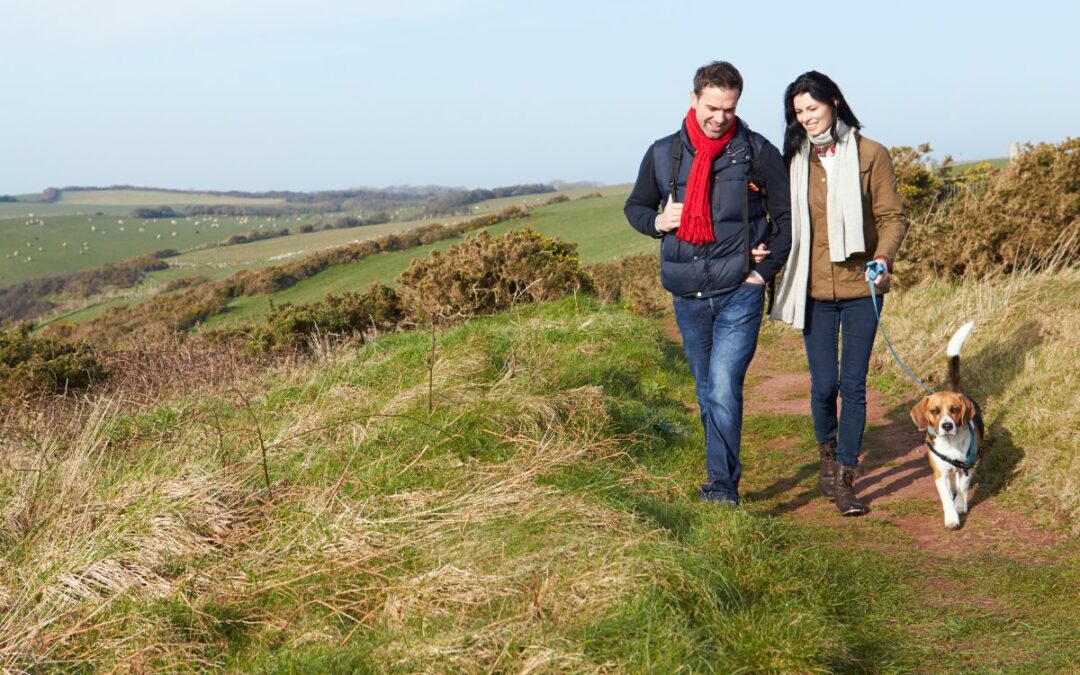Do you want to lose fat, feel better, and live longer? If so, you might want to consider walking more.
Walking is one of the simplest and most effective ways to burn fat and improve your overall health.
In this blog post, talk about why walking is so beneficial for fat loss, and how you can incorporate more walking into your daily routine.
Benefits of Walking for Fat Loss
Walking has many advantages over other forms of exercise when it comes to fat loss.
Here are some of the advantages of walking:
Walking burns more calories than you probably think!
Walking can burn up to 800 calories for an 180lb person walking 10km (6.2 miles). That’s equivalent to about two slices of pizza or four chocolate chip cookies. Not bad, right?
Walking taps into fat stores more than higher intensity exercise.
When you walk, your body uses a greater percentage of energy from fat (a process called beta-oxidation) than when you run or sprint (1, 2). This means you’re burning more fat and preserving more muscle, which is important for maintaining your metabolism and body composition.
Walking blunts appetite so it’s easier to maintain a calorie deficit.
Unlike running or other intensive cardio, which can stimulate hunger hormones and spike your appetite, walking helps you control your cravings and overeating (3).
This is because walking is a low-stress activity that doesn’t trigger the fight-or-flight response in your body (4). Instead, it relaxes you and keeps you focused on something other than food.
Walking creates a significant calorie deficit to induce fat loss with proper nutrition.
The key to losing fat is to consume fewer calories than you burn.
As long as you eat a balanced diet that meets your nutritional needs, walking can help you create a sustainable calorie deficit that leads to fat loss over time (5).
Walking reduces the risk of obesity and its related diseases.
Studies show that the risk of obesity is much lower (43% vs 53-60%) in cities that encourage walking, such as New York, London, or Paris, compared to cities that are more car-dependent, such as Houston, Atlanta, or Los Angeles (6).
This is not only because of the calories burned, but also because of the environmental and social factors that influence walking behavior.
Walking-friendly cities tend to have more green spaces, public transportation, and social interactions, which all promote physical and mental health.
Walking also lowers the risk of diabetes by 30-50%, independent of obesity, by improving blood sugar control and insulin sensitivity (7).
Additional Health Benefits of Walking
Besides burning fat, walking has many other health benefits that can improve your quality of life.
Here are some of them:
Walking improves your mood, creativity, and ideas.
Walking can boost your mood by releasing endorphins , the feel-good hormones, in your brain (8).
It can also enhance your creativity and idea flow by stimulating the regions of the brain that are involved in imagination and problem-solving. One Stanford University study found it can boost creative output by a whopping 60% (9).
Walking can also foster social connections by allowing you to have walking conversations with your friends, family, or colleagues, which can improve your communication and relationship skills.
Walking increases your testosterone levels.
Testosterone is the hormone that regulates your sex drive, muscle mass, bone density, and energy levels. Low testosterone can lead to problems such as erectile dysfunction, low libido, depression, and fatigue (10).
Walking can help you increase your testosterone levels by improving your blood circulation and reducing your stress levels (11).
A study found that men who walked more than 8,000 steps per day had higher testosterone levels and lower risk of hypogonadism (low testosterone) than men who walked less (12).
Walking boosts your vitamin D levels through sunlight exposure.
Vitamin D is a vital nutrient that supports your immune system, bone health, and mood (13). Many people are deficient in vitamin D, especially in the winter months, when there is less sunlight.
Walking outdoors can help you get more vitamin D by exposing your skin to the sun’s rays. Just make sure to wear sunscreen and avoid sunburns.
Walking causes low oxidative stress and spares your muscle tissue.
Oxidative stress is the damage caused by free radicals, which are unstable molecules that can damage your cells and DNA. Over time oxidative stress can lead to aging, inflammation, and chronic diseases (14).
Walking causes low oxidative stress compared to other forms of exercise, which means it protects your cells from damage and preserves your muscle tissue (15). This is important for maintaining your strength, mobility, and functionality as you age.
How Many Steps Do You Need?
How much walking do you need to do to enjoy these benefits? The answer depends on your goals, fitness level, and lifestyle.
A 2023 meta-analysis, published in the European Journal of Preventive Cardiology analyzed seventeen long-term studies with over 226,000 participants an average age of 64. They found walking 3,867 steps a day was enough to begin reducing the risk of all causes of death. And only 2,337 steps per day was found to risk of dying from heart disease (16).
If you want to use walking to reach fitness goals, here are some general guidelines to follow:
- Aim for at least 8000-10,000 steps per day to start. This is equivalent to about 5 miles or 8 kilometers of walking, which can burn around 400 calories for an 180lb person. This is a good baseline to maintain your health and prevent weight gain.
- Increase your steps to 12,000-14,000 per day for optimal fat burning. This is equivalent to about 6-7 miles or 10-11 kilometers of walking, which can burn around 500-600 calories for an 180lb person. This is the ideal range to create a significant calorie deficit and induce fat loss, without increasing your hunger or cravings too much.
- Follow the example of our ancestors, who averaged 16,000-17,000 steps per day. This is equivalent to about 8-9 miles or 13-14 kilometers of walking, which can burn around 800-900 calories for an 180lb person. This is the ultimate level of walking for optimal health and longevity, but it may not be realistic or necessary for most people.
Fit Tip: To keep track of your steps download a step tracking app onto your smartphone. But a fitness watch can be more convenient option. With options for every budget, you can score one on Amazon from $20 to over $200.
Tips to Incorporate More Walking into Your Daily Routine
You might be wondering how you can fit more walking into your busy schedule.
The good news is that walking is a convenient activity that you can do almost anywhere, anytime.
Here are 6 tips to help you get more steps in your day!
- Schedule it into your day. Make walking a priority and a habit by setting a specific time and place for it. For example, you can walk before or after your meals, during your lunch break, or in the evening. You can also use a calendar or an app to remind you of your walking appointments.
- Walk while on phone calls. If you have to make or take a phone call, why not do it while walking? You can use a headset or earphones to free your hands and walk around your house, office, or neighborhood. This way, you can multitask and get some steps in while having a conversation.
- Stand or pace during zoom meetings. If you have to attend a zoom meeting, you don’t have to sit still and stare at the screen. You can stand up and pace around your room, or even walk outside if the connection is good. This can help you stay alert and engaged, as well as burn some calories.
- Park farther away at stores. If you have to drive to a store, don’t look for the closest parking spot. Instead, park farther away and walk the extra distance. This can add up to a lot of steps over time, and also save you some gas money.
- Walk your kids or dogs. If you have kids or dogs, you have a great opportunity to walk more. You can take them to a park, a playground, or a trail, and have some fun and quality time with them. You can also join a walking group or club with other parents or pet owners, and make some new friends.
- Explore new places while traveling. If you travel for work or pleasure, you can use it as a chance to walk more and discover new places. You can walk around the airport or the venue during delays or downtime, or explore the city or the countryside during your free time. You can also use a map or a guide to find interesting landmarks, attractions, or restaurants to walk to.
Scaling Up Walking
If you want to challenge yourself and make walking more interesting and effective, you can try some of these variations:
- Add hills or stairs. Walking uphill or climbing stairs can increase the intensity and difficulty of walking, and also target different muscles in your legs and glutes. You can find hills or stairs in your neighborhood, or use a treadmill or a stair machine at the gym. You can also use a backpack or a vest to add some weight and resistance.
- Carry weights. Another way to make walking harder is to carry some weights in your hands or on your body. You can use dumbbells, kettlebells, or water bottles, and swing them as you walk. You can also use a backpack or a vest to add some weight and resistance. Just make sure to start with light weights and increase gradually, and avoid any pain or discomfort in your joints or muscles.
- Walk on grass or sand. Walking on uneven or soft surfaces can challenge your balance and stability, and also work your feet and ankles more. You can walk on grass, sand, or dirt, and feel the difference in your muscles and joints. You can also go barefoot or wear minimalist shoes to enhance the sensation and the benefits.
- Walk backwards or sideways. Walking in different directions can activate different muscles and movements, and also improve your coordination and agility. You can walk backwards or sideways, or do a side shuffle or a crossover step. You can also change directions frequently, or follow a zigzag or a circular pattern. Just make sure to be aware of your surroundings and potential obstacles. You can also do this with a partner or a trainer who can guide you and give you feedback.
- Get more NEAT: NEAT (non-exercise activity thermogenesis) is all the energy we spend doing anything that isn’t sleeping, eating, or a dedicated workout. It includes activities, like standing, walking, fidgeting, toe-tapping, shuffling things, and other movements that are part of our daily routine. And it can add a lot more steps and calorie burn to your day. Here are 36 ways to increase your NEAT during the day.
How Walking Burns Fat
One of the main reasons why walking is so effective for fat loss is that it taps into your fat stores more than other forms of exercise.
When you walk, your body uses a mix of carbohydrates and fats as fuel, but the ratio depends on the intensity and duration of the activity. The higher the intensity, the more carbohydrates you use, and the lower the intensity, the more fats you use.
Walking is a low to moderate intensity activity, which means it uses a higher percentage of energy from fat than from carbohydrates.
This is especially true if you walk for longer than 30 minutes, which is when your body switches to a more fat-burning mode. This is called beta-oxidation, which is the process of breaking down fatty acids into energy.
While walking burns fewer calories than running or other high intensity exercise, it burns more fat calories, which is what matters for fat loss.
For example, if you run for 30 minutes, you might burn 300 calories, but only 100 of them from fat. If you walk for 30 minutes, you might burn 150 calories, but 90 of them from fat.
So, even though you burn less total calories, you burn more fat calories, which is more beneficial for your body composition and metabolism.
Another advantage of walking is that it preserves your muscle tissue more than other forms of cardio training (17). The more muscle you have, the higher your resting metabolic rate (RMR), which is the amount of calories you burn in a day without any activity.
If you lose muscle, your RMR decreases, which makes it harder to lose fat and easier to gain it back.
Walking preserves muscle, and can even stimulate growth and repair, especially in your legs and glutes. This can help you maintain or increase your RMR and keep your fat loss going (18).
Walking Can Help Suppress Appetite
As you probably know, the key to losing fat is to create a calorie deficit, which means you have to eat less than you burn. However, this can be challenging, especially if you feel hungry or crave unhealthy foods.
But walking can help suppress your appetite and reduce cravings (19).
This is because walking is a low-stress activity that does not trigger the fight-or-flight response in your body.
The fight-or-flight response is a survival mechanism that prepares you for danger or threat. It increases your heart rate, blood pressure, and adrenaline, and also stimulates your hunger and thirst, to give you more energy and resources to cope with the situation (20).
Unfortunately the modern fight-or-flight experience is usually our stress response to non life-threatening situations, such as work deadlines, traffic jams, or arguments. This can cause us to overeat or binge on junk food, which can sabotage our fat loss efforts (21).
High intensity exercise can also trigger the fight-or-flight response, which can increase your appetite and make you eat more than you need (22).
Instead walking, activates our the rest-and-digest response, a relaxation mechanism that calms you down and restores your balance. It lowers your heart rate, blood pressure, and cortisol, and also reduces your hunger and thirst, to allow you to digest and absorb your food better (23).
Walking can also improve your mood and self-esteem, which can reduce your emotional eating and bingeing (24, 25).
Walking Boosts Testosterone
Testosterone is the hormone that regulates your sex drive, muscle mass, bone density, and energy levels.
Testosterone levels tend to decline with age, especially after 40, but they can also be affected by lifestyle factors such as diet, exercise, stress, and sleep. Walking can help you increase your testosterone levels by improving your blood circulation and reducing your stress levels.
A 2021 study published in the journal Endocrine found (26):
- Men who walked more than 8,000 steps per day had higher testosterone levels and lower risk of hypogonadism (low testosterone).
- Men who walked more than 8,000 steps per day had 15% higher testosterone levels and 68% lower risk of hypogonadism than the men who walked less than 3,000 steps per day.
- Men who walked more than 12,000 steps per day had 22% higher testosterone levels and 87% lower risk of hypogonadism than the men who walked less than 3,000 steps per day.









